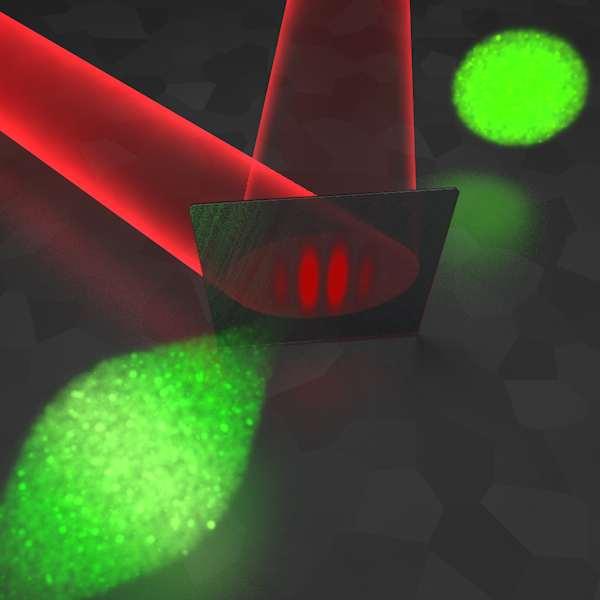Physicists at the University of Konstanz have demonstrated the ability to spatially and temporally direct and control ultrashort electron pulses by using the light cycles of lasers. The new technique not only shortens pulse duration, but also allows the pulses to be “tilted,” that is, allows the pulses to be shaped to run in a direction that is other than vertical to the pulse front. This technology could be used for materials studies in the ultrafast ranges.

Electrons (green) reshape into tilted pulses by interference with a beam of laser-generated terahertz radiation (red). Courtesy of P. Baum.
The Konstanz team collaborated on the research with scientists at the Ludwig Maximilian University Munich (LMU) and the Max Planck Institute of Quantum Optics.
The team used single-cycle terahertz radiation beamed at an electron-transmitting mirror at slanted orientation to generate and characterize the tilted electron pulses. Femtosecond electron pulses with a chosen tilt angle were produced.
Tilted electron pulses could support materials studies in which the fundamental changes last only for femtoseconds or attoseconds. Tilted pulses also could be used by free-electron lasers for producing more intense and shorter x-ray flashes for analyzing ultrafast processes.
Tracking atomic movements requires ultrashort measurement periods in the femtosecond and attosecond ranges. Such extremely fast speeds are reached through ultrashort electron pulses that are shorter than the time scale of the motion. The shorter the pulse, the higher the resolution. Equally important, however, is the ability to shape the electron pulses in space and time, to adjust the pulses to the properties of the substance that is being tracked.
“Our results show that we can now shape and control electron pulses as eclectically as laser pulses, at the imaging resolution of modern electron microscopy,” said professor Peter Baum.
In laser optics it has been known for some time that the different colors must run in different directions. In its experiments, the team demonstrated that the old laws of laser optics also apply to the matter wave of electrons, even though electrons have a rest mass and are not coherent like laser light. The experimental results indicate that ultrashort electron pulses can be shaped in space and time with as much versatility as femtosecond laser pulses, but with a finer wavelength and subnanometer imaging resolution.
The team’s experiments, along with theoretical analysis, further indicate that the pulse front tilt in electron optics is directly connected to angular dispersion. Quantum mechanical considerations suggest that this connection is general for particle beams at any degree of coherence.
The research was published in Physical Review Letters (doi:10.1103/PhysRevLett.121.094801).